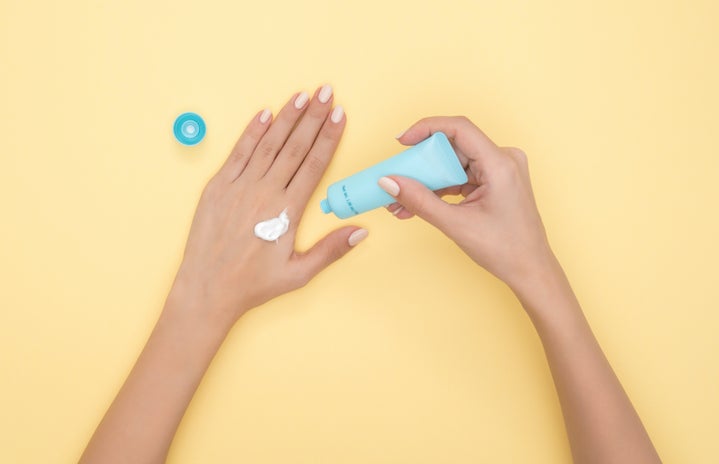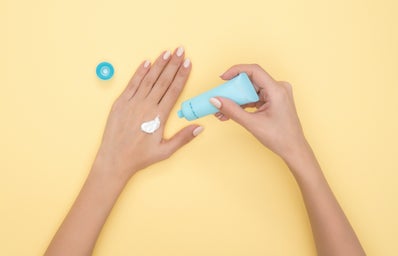Sometimes when I stumble upon skincare TikTok, I learn about different serums and how they can help your skin. There are many differing opinions on what a daily skincare routine should look like, however, there is one thing that many of these influencers agree on: sunscreen. There are many benefits to sunscreen, such as anti-aging and reduced risk of skin cancer, however, there is a lot to learn in the world of sunscreen. Keep reading to get an overview!
Benefits of Sunscreen
The biggest benefit of wearing sunscreen is that it protects your skin from UV rays. The continuous depletion of the ozone layer makes us more prone to sun damage from harmful UV rays. Sunscreen blocks these rays, which reduces your risk of sunburns. Another benefit of wearing sunscreen is that it lowers your risk of skin cancer. According to the American Academy of Dermatology, skin cancer is the most common form of cancer in the U.S. The damaging UV rays are a major cause for melanoma. By applying sunscreen daily, you cut your risk of skin cancer in half. UV rays can also cause premature aging of the skin. The rays cause photoaging, which makes the skin look leathery and discolored. Additionally, the rays cause a breakdown of collagen, which contributes to fine lines and wrinkles. Wearing sunblock can prevent this. Finally, wearing sunscreen daily can help maintain an even skin tone.
Chemical vs. Mineral Sunscreen
There are two major types of sunscreen: chemical and mineral. Both help protect you from the sun, however, the way they shield your skin differs. Usually, for certain skin types, one type might beat the other.
With mineral sunscreens, ingredients such as zinc oxide and titanium dioxide sit on the skin and prevent harmful UV rays from penetrating into the skin. Some advantages to mineral sunscreens are that the two most common ingredients have been recognized by the FDA as safe and effective. Mineral sunscreens also start offering protection immediately after applying it rather than having to wait 20 to 30 minutes. Some disadvantages include that mineral sunscreens are thicker than chemical sunscreens, and they can lead to breakouts on acne-prone skin. Mineral sunscreens also leave a white cast on the skin because they are a little more difficult to apply.
Meanwhile, chemical sunscreens allow light to be absorbed into the skin. Ingredients such as oxybenzone and octocrylene create a chemical reaction where the UV rays are turned into heat and the heat dissipates from the skin. Advantages include that chemical sunscreens do not leave a white cast on your skin and they are easier to apply. Chemical sunscreens also perform better in studies that look into how much they protect the skin from UV rays. However, some disadvantages include that chemical sunscreens may cause skin reactions in certain people with sensitive skin and it can worsen pre-existing melasma and rosacea.
How Much and How Often Should You Apply Sunscreen?
There is no definitive consensus on how much sunscreen you should be applying to your face every day. Some say you need three fingers worth, while others say about the size of your palm’s worth. According to Johns Hopkins Medicine, you should use one ounce of sunscreen for your whole body. One ounce of sunscreen is equivalent to a shot glass’ worth of sunscreen. Since your face and neck make up 4 percent of your body, you would need about .04 ounces worth of sunscreen. 0.04 ounces is equivalent to two fingers of sunscreen, which is equivalent to filling the bottom of a shot glass, a nickel sized dollop or ¼ of a teaspoon.
The next question is: What level of SPF do you need to effectively protect yourself from the harmful UV rays? For daily use, an SPF of 30 is what is recommended. However, if you tend to spend a lot of time outdoors, an SPF of 60 is recommended. The truth is that many people do not apply enough sunscreen, so a higher SPF can compensate for that.
Reapplying sunscreen is key because your sunscreen starts to break down as it blocks the harmful UV rays from the sun. If you are outdoors or swimming, it is recommended that you reapply every 2 hours. For a normal day, it is recommended that you reapply sunscreen every 3 to 4 hours. I always forget to reapply, so I keep a timer on my phone! Remember, beach and pool days are not the only time you are exposed to the sun; Walking to classes on campus and dining outdoors add up! People say that cloudy days are the highest occurrence for sun burns, however, it is because less people wear sunscreen on cloudy days. Even if the sun is blocked by clouds, UV rays still penetrate through.
Sunscreen Recommendations
These recommendations come from what I see on social media, but also the ones that I have tried!
- SPF 40
- Price: $20
Skin Aqua UV Super Moisture Gel
- SPF 50
- Price: $12.99
- SPF 36
- Price: $15
- SPF 50
- Price: $13
- SPF 55
- Price: $8
Sunscreen Reapplication Pro Tip!
One thing that always bothers me when it comes to reapplying sunscreen is unclean hands. When I’m out, reapplying lotion sunscreen and rubbing it in with unwashed hands bothers me. My solution to the problem includes carrying stick sunscreen! It kind of looks like deodorant. That way, all you have to do is rub the stick all over your face and body and you are good to go! Additionally, to reapply sunscreen on top of makeup, there are many setting sprays and powders that contain SPF!
It is estimated about 10,000 Americans are diagnosed with skin cancer per day. The major cause of skin cancer is exposure to the harmful UV rays from the sun. Fortunately, you can evade the negative effects of the sun by wearing sunscreen! As this article summarizes, there are many different types of sunscreens to find the perfect one for you.


